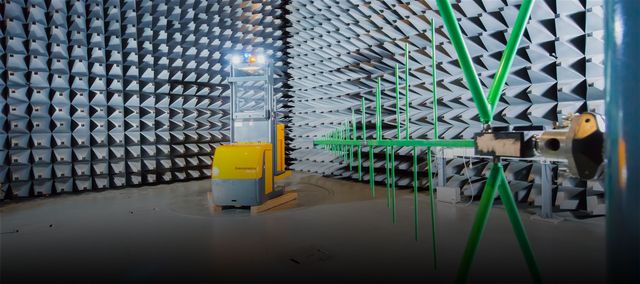8 September 2016
It is essential for electronic devices to operate faultlessly alongside one another: products are tested for electromagnetic compatibility in the laboratory by TÜV NORD before their market launch.
The 120-square-metre room with its 6.5 metre ceiling is bound to fill any layman with awe. Because, protruding menacingly from the walls and the ceiling are what look like a large number of oversized pencil points. Masses of cables on the floor and a large antennae targeted at a vehicle in the hall add to the futuristic atmosphere. And yet, no science fiction film is being shot here. Being tested on this occasion in the TÜV NORD laboratory for electromagnetic compatibility (EMC) is a vertical order picker, a warehousing vehicle that allows its operator to work at greater heights. The dangerous-looking points are, on closer inspection, made of foam and act as absorbers of electromagnetic waves. Meaningful and accurate testing would not be possible without them. The modern laboratory with its large anechoic chamber is suitable for testing everything from small radios right up to electric cars that can be driven into the hall.
© Hauke HassInterference immunity is tested. The order picker must be able to work without being interfered from electromagnetic fields.
There are only a few laboratories in Germany capable of testing such a wide range of products as that operated by TÜV NORD in Hamburg-Harburg. Regardless of where they are found – in offices, living rooms, clinics or large warehouses – ever larger numbers of electronic devices and systems are required to function flawlessly alongside one another. This means that no device may be permitted to “interfere” with any other – what is meant here is the electromagnetic compatibility of every single product. Most devices from the household and industrial technology, consumer electronics and medical technology fields – and even cars – are for this reason tested for electro-magnetic compatibility before they go into series production. “Passing the EMC test is a prerequisite for all products with electronic parts that need to be approved for market release,” explains Thomas Weber, head of the EMC laboratory of TÜV NORD.
Devices must pass tests
The background to this is EU Directive 2014/30/EU, which makes EMC testing mandatory for many devices if they are to be sold on the European market. This applies not just to devices for everyday use but also to a variety of industrial appliances such as, for example, those used in automatic control engineering. If the device complies with the requirements it receives the familiar CE mark. This is not a test mark: it is instead an administrative symbol which shows that appropriately qualified industrial products may be freely sold on the European internal market. The sale without CE marking of devices which fall within the scope of the directive has been banned since 1996.
© Hauke HassThe ESD test is run by Jörg Plambeck and Michael Wiese.
Decathlon in the laboratory
The vertical order picker being tested on this day by the EMC specialists from TÜV NORD was manufactured by Jungheinrich. The Hamburg-based group is one of the leading international companies in the fields of floor-level conveyors, warehousing and material flow technology. Being tested in the EMC laboratory is an advanced vertical order picker which will in the future have to navigate around the racks of large logistics centres and extract articles from different rack heights.
“We collaborate regularly with TÜV NORD, right from the development stage, to get our products tested for their electromagnetic compatibility,” says Michael Wiese of Jungheinrich AG. “For us a testing procedure is like a decathlon. The products to be inspected must pass muster in several disciplines and demonstrate their electromagnetic compatibility,” explains Thomas Weber.
“We collaborate regularly with TÜV NORD, right from the development stage.”
Two test runs necessary
In the anechoic chamber, two different test runs take place. First of all, the larger antennas are used to test radiated emissions. The purpose of this test is to establish whether the order picker will interfere with other equipment. “If the vehicle doesn’t pass this test it might mean that it could interfere with computers it passes in the warehouse,” says Michael Wiese.
Measurements are taken at a standard distance of ten metres. This is to ensure that other devices will not be interfered with. this first test lasts for two hours; a second test verifies what is known as the radiated immunity of the vehicle. This means that the picker can work without functional impairment in conditions of exposure to electromagnetic interference from the outside. In order to ensure that the picker is immune to interference, it is exposed to electromagnetic radiation from the sides. An electromagnetic discharge (ESD) test is then performed. Jungheinrich has decades of experience with this type of vehicle, but any technical change, no matter how small, can affect immunity. This is unpredictable, even for specialists. “Sometimes all it takes for interference to arise is a change in the routing of a cable,” Mr Wiese says.
Latest technologies
The testing laboratory in Hamburg-Harburg has been part of TÜV NORD since 1997 and was incorporated into TÜV NORD CERT in early 2010. It has been accredited by the German Accreditation Body and recognised as a testing laboratory by the Federal Motor Vehicle Transport Authority.
The laboratory is constantly adapting its range of services to the state of the art according to technical progress in the area of EMC. “In our laboratory we are always testing state-of-the-art products,” says Thomas Weber. This offers fascinating insights into the current development of booming industries with new, innovative products that need to be tested for their electromagnetic compatibility. This currently applies especially to new products in the fields of smart homes (such as smoke detectors) and Green energy (frequency converters).
© Hauke HassThe EMC measurements are evaluated on a computer next to the lab.
Manufacturers of marine equipment and medical equipment also get their products tested by the Hamburg-based laboratory. It is particularly important for hospitals that their equipment should function faultlessly and without mutual interference. Accordingly, electromagnetic compatibility is mandatory for most medical devices and must be tested by accredited laboratories such as that of TÜV NORD.
Proximity to the port of Hamburg and the companies based there offers good testing conditions for marine equipment products such as, for example, LED lighting. Several thousand luminaires are installed on container and cruise ships. “But our customers are by no means restricted to Hamburg alone. Manufacturers from Denmark and Sweden also get us to perform EMC tests for them,” says Weber.
Not all devices pass
As well as carrying out conformity testing, Weber’s team works closely with customers during the product development phase. Interference analyses provide valuable clues to help solve electromagnetic problems. The Jungheinrich vertical order picker passes all the test stages on the day of the test. “But not every device sails through like this,” says Thomas Weber. It might be that there is a problem on just one single frequency. The team then joins forces with the manufacturer’s design engineers to conduct a joint failure analysis.
YOU MAY ALSO LIKE
 Gorodenkoff Productions / AdobeStock
Gorodenkoff Productions / AdobeStockWhat does ISO 9001:2015 mean?
Quality and customer satisfaction are the decisive criteria for the success of a company.
Read more
ACCREDITED TESTS IN ACCORDANCE WITH MORE THAN 80 EMC STANDARDS
- Radiated emissions
- Conducted emissions – such as, for instance, interference voltage and parasitic current measurements up to 500 MHz, harmonics measurements and flicker
- Immunity to radiation fields
- Immunity to conducted interferences (RF, Burst Surge)
- Electrostatic discharge (ESD)
- Additional tests – of grid quality as well as grid interference and analysis of harmonics. Complete testing service in conjunction with the experts from TÜV NORD
- Development support – with helpful interference analyses and tests at the premises of the customer
EMV LABOR TÜV NORD CERT
Harburger Schlossstraße 6-12
21079 Hamburg
Germany
JUNGHEINRICH AG
Friedrich-Ebert-Damm 129
22047 Hambrug




